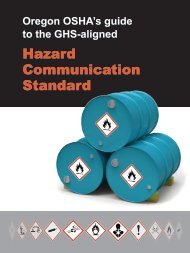Technical Manual - Section 3 (Safety Hazards)
Technical Manual - Section 3 (Safety Hazards)
Technical Manual - Section 3 (Safety Hazards)
You also want an ePaper? Increase the reach of your titles
YUMPU automatically turns print PDFs into web optimized ePapers that Google loves.
Figure III:2-9 Vacuum Distillation<br />
SOLVENT EXTRACTION AND<br />
DEWAXING<br />
Solvent treating is a widely used method of refining<br />
lubricating oils as well as a host of other refinery stocks.<br />
Since distillation (fractionation) separates petroleum products<br />
into groups only by their boiling-point ranges, impurities may<br />
remain. These include organic compounds containing sulfur,<br />
nitrogen, and oxygen; inorganic salts and dissolved metals;<br />
and soluble salts that were present in the crude feedstock. In<br />
addition, kerosene and distillates may have trace amounts of<br />
aromatics and naphthenes, and lubricating oil base-stocks<br />
may contain wax. Solvent refining processes including<br />
solvent extraction and solvent dewaxing usually remove these<br />
undesirables at intermediate refining stages or just before<br />
sending the product to storage.<br />
SOLVENT EXTRACTION<br />
The purpose of solvent extraction is to prevent corrosion,<br />
protect catalyst in subsequent processes, and improve finished<br />
products by removing unsaturated, aromatic hydrocarbons<br />
from lubricant and grease stocks. The solvent extraction<br />
process separates aromatics, naphthenes, and impurities from<br />
the product stream by dissolving or precipitation. The<br />
feedstock is first dried and then treated using a continuous<br />
countercurrent solvent treatment operation. In one type of<br />
process, the feedstock is washed with a liquid in which the<br />
substances to be removed are more soluble than in the desired<br />
resultant product. In another process, selected solvents are<br />
added to cause impurities to precipitate out of the product. In<br />
the adsorption process, highly porous solid materials collect<br />
liquid molecules on their surfaces.<br />
III:2-20
















